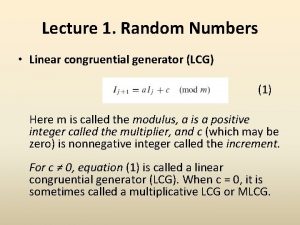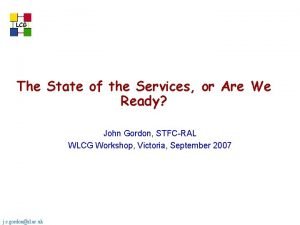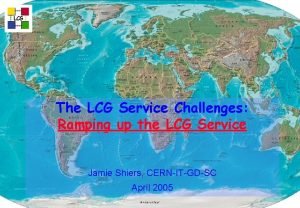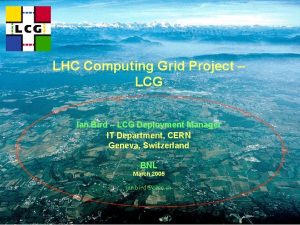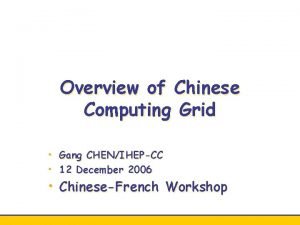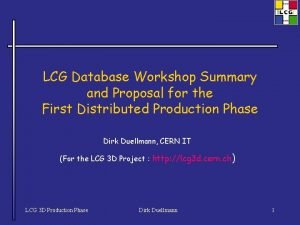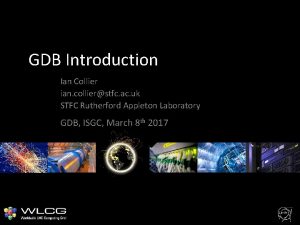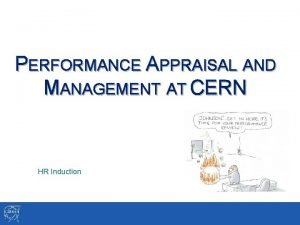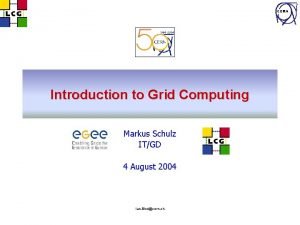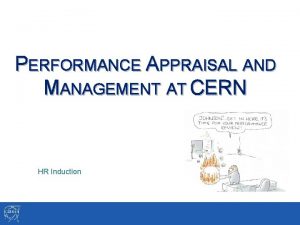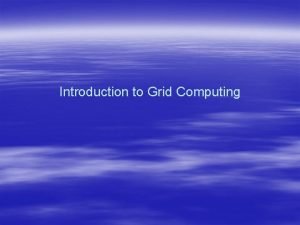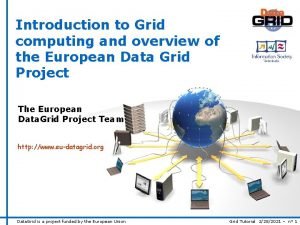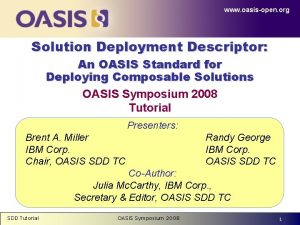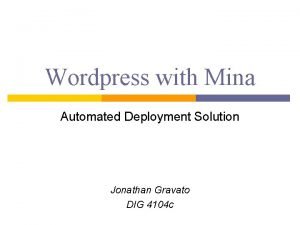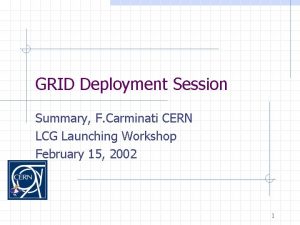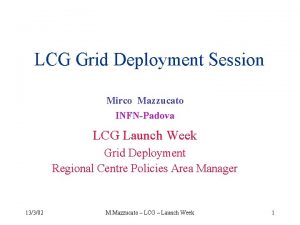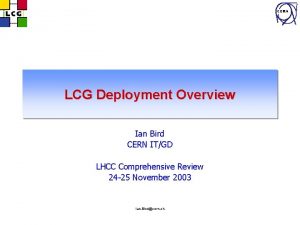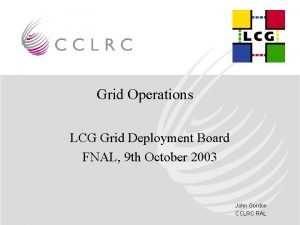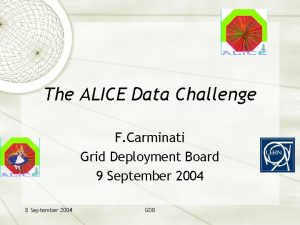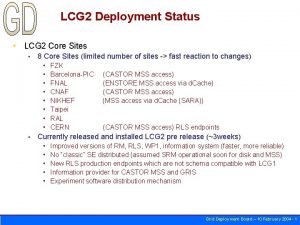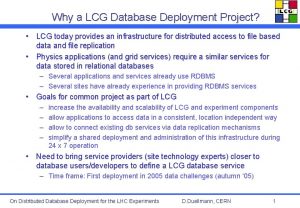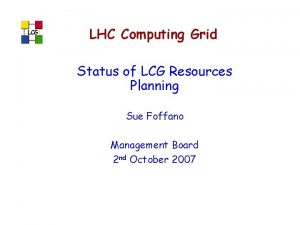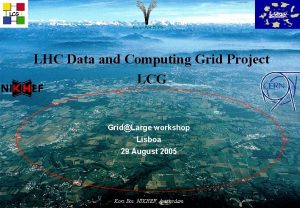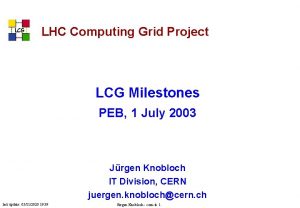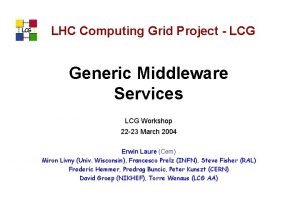GRID Deployment Session Introduction F Carminati CERN LCG

















- Slides: 17

GRID Deployment Session Introduction, F. Carminati CERN LCG Launching Workshop February 13, 2002 1

Agenda 14: 00 Agenda and Scope F. Carminati (CERN) 14: 20 GRID deployment M. Mazzucato (INFN) 14: 50 Presentation from funding agencies / countries Holland, M. Mazzucato (on behalf of K. Bos, NIKHEF) Germany, M. Kunze (Karlsruhe) IN 2 P 3, D. Linglin (Lyon) INFN-Italy, F. Ruggieri (CNAF-INFN) Japan, I. Ueda (Tokyo) Northern European Countries, O. Smirnova on behalf of J. Renner Hansen (NBI DK) 16: 00 Coffee Break Russia, V. A. Ilyin (SINP MSU Moscow) UK, J. Gordon (RAL) US-ATLAS, R. Baker (BNL) US-CMS, L. Bauerdick (FNAL) US-ALICE, B. Nilsen (OSU) Spain, M. Delfino 16: 20 Proposal for Coordination Mechanisms L. Robertson 16: 50 Discussion March 12, 2002 SC 2 2

LHC computing at a glance The investment in LHC computing will be massive n n LHC Review estimated 240 MCHF (before LHC delay) 80 MCHF/y afterwards These facilities will be distributed n Political as well as sociological and practical reasons Europe: 267 institutes, 4603 users Elsewhere: 208 institutes, 1632 users March 12, 2002 SC 2 3

Beyond distributed computing Every physicist should have equal access to data and resources The system will be extremely complex n n Number of sites and components in each site Different tasks performed in parallel: simulation, reconstruction, scheduled and unscheduled analysis We need transparent access to dynamic resources Bad news is that the basic tools are missing n n Distributed resource management, file and object namespace and authentication Local resource management of large clusters Data replication and caching Understanding of high speed networking Good news is that we are not alone n All the above issues are central to the new developments going on in the US and Europe under the collective name of GRID March 12, 2002 SC 2 4

Resource estimate Source: LHC computing review + recent corrections n n n n Event size 0. 1 -25 MB Data rate 20 -1250 MB/s Disk@CERN ~0. 5 PB/exp Disk@Tier 1 0. 15 -0. 6 PB/exp Tape@CERN 0. 7 -9 PB/exp Tape@Tier 1 0. 2 -1. 8 PB/exp CPU@CERN 200 -800 k. SI 95/exp CPU@Tier 1 120 -250 k. SI 95/exp Average of 0. 8 GB/s per experiment in Tier 0 Estimated uncertainty in the numbers = factor 2 ± 10% in Moore’s law over 4 years = factor 2. 7 March 12, 2002 SC 2 5

Planning With a total factor approaching one order of magnitude plans are very quickly outdated For the same very reasons, continual planning is necessary to reduce uncertainties However we need experimental points to support our extrapolations Therefore: n Test. Beds at all levels are necessary to establish these points and continuously assess the evolution of technology and computing model March 12, 2002 SC 2 6

Scalability? The ALICE Data Challenge example When using COTS the question n Is your architecture scalable? Is replaced by n Have you been there or not? March 12, 2002 SC 2 7

Physics challenges Experiments need simulation, reconstruction and analysis for n n Detector design Algorithm development HLT studies Refinement of the computing model Objectives of Physics Challenges is the physics output n Technology output is parasitical, but very important An excellent occasion to deploy and test a global computing model Realistic test of the results of the LCG project n This is the proof of reality of the whole mechanism going from requirements (SC 2) to code (PEB/WP) Experiments are already doing this routinely, but on separated testbeds with different tools n A lot of ground here for scale economy of tools and configurations March 12, 2002 SC 2 8

Data Challenges The average bandwidth needed in the Tier 0 has been calculated around ~0. 8 GB/s per experiment in pp mode n This includes writing, reading back, exporting, analysing etc Unfortunately we are very far from knowing how to do it Here we need technology-driven challenges that verify the evolution of the Tier 0 model For the moment ALICE is leading the way in this area n n Due to the famous 1. 25 GB/s requirement in HI Other experiments follow, collaborate, share the results and this is all working very well These performance driven challenges can include remote centres n Prompt data replication, remote monitoring or distributed prompt reconstruction March 12, 2002 SC 2 9

Bringing all this together The concept of Data Challenge and testbed is central to the development of the LHC Computing GRID Project This is where LCG shows its intrinsically distributed nature And where probably planning becomes more complicated n And instructive / useful How to do this is the subject of this area March 12, 2002 SC 2 10

Data Challenge issues Data Challenges are very intensive in personnel and equipment n And a large effort from the experiments, almost like a testbeam Experiments have made Data Challenges an integral part of their planning n These plannings are under constant evolution Planning and commitment to resources and timescales are essential from all sides Close collaboration is needed between LCG, IT at CERN, remote centres and the experiment to create the conditions for success This activity has to be seen as a clear priority for the whole project March 12, 2002 SC 2 11

GRID opportunities GRID (mostly GLOBUS / Condor) already facilitate the day -to-day work of physicists in large distributed productions To go forward, we need to deploy a pervasive, ubiquitous, seamless GRID testbed between all the sites providing cycles to LHC n n Or at least something as close as possible to this And possibly include other HEP and non HEP activities Some of the components of the basic technology are or will be there in the near future n II, Resource Broker, Replica Manager, automatic installation, authentication/authorisation, monitoring… Question is how do we deploy/make use of them March 12, 2002 SC 2 12

GRID issues – Support Testbed need close collaboration between all parties n Tier 0, Tier 1’s, experiments, GRID (MW) projects Support for the testbed is very labour intensive n n n VO support Application integration Local System Support MW support Escalation of user problems Experience of EDG testbed (MW+applications) very important Again a planning and resource commitment is necessary to obtain successful testbeds Need development and Production testbeds running in parallel n And stability, stability Experiments are buying into the common testbed concept, they should not be deceived March 12, 2002 SC 2 13

GRID issues – Technology MW from different GRID projects is at risk of diverging n i. VDGL, PPDG, Data. GRID, Gri. Phy. N, Cross. GRID From bottom-up SC 2 has launched a common use case RTAG for LHC experiments n n Some of the work already started in Data. GRID Possibly to be extended to other sciences within Data. GRID From top-down there are coordination bodies n HICB, HIJTB, GLUE, GGF LCG has to find an effective way to contribute and follow these processes n Increase communication and do not develop parallel structures March 12, 2002 SC 2 14

GRID issues – Interoperability At the end there will be one GRID or zero n n You may or may not subscribe to this We may not afford more … or at least less GRIDs than computing centres! Interoperability is a key issue n n Select common components? Make different components interoperate? … on national / regional testbeds n … too many to mention them all … or transatlantic testbeds n Data. TAG, i. VDGL March 12, 2002 SC 2 15

GRID issues – Coordination Key to all that is coordination between different centres This kind of world-wide close coordination has never been done in the past We need mechanisms here to make sure that all centres are part of a global planning n In spite of their different conditions of funding, internal planning, timescales etc And these mechanisms should be complementary and not parallel or conflicting to existing ones n See Les’ talk March 12, 2002 SC 2 16

Conclusions A challenge in the challenge n It is here that technology comes in contact with politics GRID deployment and Data Challenges will be the proof of the existence of the system n Where it all comes together Complicated scenario, manifold role for LCG n n n Follow technology Complement existing GRID coordination Harmonize planning of different experiments and Project Provide support and collaborate with experiments Deploy and support testbeds and Data Challenges March 12, 2002 SC 2 17

